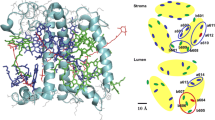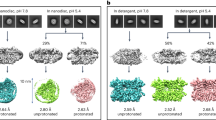Abstract
Low temperature (4.2 K) absorption and hole burned spectra are reported for a stabilized preparation (no excess detergent) of the photosystem II reaction center complex. The complex was studied in glasses to which detergent had and had not been added. Triton X-100 (but not dodecyl maltoside) detergent was found to significantly affect the absorption and persistent hole spectra and to disrupt energy transfer from the accessory chlorophyll a to the active pheophytin a. However, Triton X-100 does not significantly affect the transient hole spectrum and lifetime (1.9 ps at 4.2 K) of the primary donor state, P680*. Data are presented which indicate that the disruptive effects of Triton X-100 are not due to extraction of pigments from the reaction center, leaving structural perturbations as the most plausible explanation. In the absence of detergent the high resolution persistent hole spectra yield an energy transfer decay time for the accessory Chl a QY-state at 1.6 K of 12 ps, which is about three orders of magnitude longer than the corresponding time for the bacterial RC. In the presence of Triton X-100 the Chl a QY-state decay time is increased by at least a factor of 50.
Similar content being viewed by others
Abbreviations
- PS I:
-
photosystem I
- PS II:
-
photosystem II
- RC:
-
reaction center
- P680, P870, P960:
-
the primary electron donor absorption bands of photosystem II, Rhodobacter sphaeroides, Rhodopseudomonas viridis
- NPHB:
-
nonphotochemical hole burning
- TX:
-
Triton X-100
- DM:
-
Dodecyl Maltoside
- Chl:
-
chlorophyll
- Pheo:
-
pheophytin
- ZPH:
-
ero phonon hole
References
Avarma RA and Rebane KK (1985) High-resolution optical spectra of chlorophyll molecules. Spectrochim Acta 41A: 1365–1380
Breton J, Martin JL, Fleming GR and Lambry JC (1988) Low temperature femtosecond spectroscopy of the initial step of electron transfer in reaction centers from photosynthetic purple bacteria. Biochemistry 27: 8276–8284
Breton J (1990) Orientation of the pheophytin primary electron acceptor and of the cytochrome b-559 in the D1–D2 photosystem II reaction center. In: Jortner J and Pullman B (eds) Twenty-second Jerusalem Symposium Quantum Chemistry and Biochemistry: Perspective in Photosynthesis, pp 23–38. Dordrecht/Boston/London: Kluwer Academic Publishers
Dekker JP, Bowlby NR and Yocum CY (1989) Chlorophyll and cytochrome b-559 content of the photochemical reaction center of photosystem II. FEBS Lett 254: 150–154
den Blanken HJ, Hoff AJ, Jongenelis APJM and Diner BA (1983) High-resolution triplet-minus-singlet absorbance difference spectrum of photosystem II particles. FEBS Lett 151: 21–27
Fleming GR, Martin JL and Breton J (1988) The primary electron transfer in photosynthetic bacteria. Nature 333: 190–192
Friedrich J, Swalen JD and Haarer D (1980) Electronphonon coupling amorphous organic host materials as investigated by photochemical hole burning. J Phys Chem 73: 705–711
Friedrich J and Haarer D (1982) Transient features of optical bleaching as studied by photochemical hole burning and fluorescence line narrowing. J Chem Phys 76: 61–68
Ghanotakis DE, de Paula JC, Demetrion DM, Bowlby NR, Peterson J, Babcock GT and Yocum CF (1989) Isolation and characterization of the 47 kDa protein and the D1–D2-Cytochrome b-559 complex. Biochem Biophys Acta 974: 44–53
Gillie JK, Fearey BL, Hayes JM, Small GJ and Golbeck JH (1987a) Persistent hole burning of the primary donor state of photosystem I: strong linear electron-phonon coupling. Chem Phys Lett 134: 316–322
Gillie JK Hayes JM, Small GJ and Golbeck JH (1987b) Hole burning spectroscopy of a core antenna complex. J Phys Chem 91: 5524–5229
Gillie JK, Small GJ and Golbeck JH (1989) Nonphotochemical hole burning of the native complex of photosystem I (PS I-200). J Phys Chem 93: 1620–1627
Hayes JM, Gillie JK, Tang D and Small G (1988) Theory for spectral hole burning of the primary electron donor state of photosynthetic reaction centers. Biochim Biophys Acta 932: 287–305
Hayes JM, Jankowiak R and Small GJ (1988) In: Moerner EW (ed) Topics in Current Physics, Persistent Spectral Hole Burning: Science and Applications, pp 153–202. Berlin: Springer-Verlag
Jankowiak R, Tang D, Small GJ and Seibert M (1989) Transient and persistent hole burning of the reaction center of photosystem II. J Phys Chem 93: 1649–1654
Johnson SG, Tang D, Jankowiak R, Hayes JM, Small GJ and Tiede DM (1989) Structure and marker mode of the primary electron donor state absorption of photosynthetic bacteria: hole-burned spectra. J Phys Chem 93: 5933–5957
Johnson SG, Tang D, Jankowiak R, Hayes JM, Small GJ and Tiede DM (1990a) New photochemical hole burning studies of bacterial reaction centers. J Phys Chem (in print)
Johnson SG, Lee I-J and Small GJ (1990b) Solid state line narrowing spectroscopics. In: Scheer H (ed) Chlorophylls. CRC Press, Boca Raton, Florida
Kobayashi M, Maeda H, Watanabe T, Nakane H and Satoh K (1990) Chlorophyll a and β-carotene content in the D1/D2/cytochrome b-559 reaction center complex from spinach. FEBS Lett 260: 138–140
Köhler W, Friedrich J, Fisher R and Scheer H (1988) High resolution frequency selective photochemistry of phycobilisomes at cryogenic temperatures. J Chem Phys 89: 871–874
Lee J-L, Hayes JM and Small GJ (1989) Hole and antihole profile in nonphotochemical hole-burned spectra. J Chem Phys 91: 3463–3469
McTavish H, Picorel R and Seibert M (1989) Stabilization of isolated PS II reaction center complex in the dark and in the light using polyethylene glycol. Plant Physiol 89: 452–456
Meech SR, Hoff AJ and Wiersma DA (1985) Evidence for a very early intermediate in bacterial photosynthesis. A photon-echo and hole-burning study of the primary donor band in Rhodopseudomonas sphaeroides. Chem Phys Lett 121: 287–292
Michel H and Deisenhofer J (1988) Relevance of the photosynthetic reaction center from purple bacteria to the structure of photosystem II. Biochemistry 27: 1–7
Nanba O and Satoh (1987) Isolation of a photosystem II reaction center consisting of D-1 and D-2 polypeptides and cytochrome b-559. Proc Natl Acad Sci USA 84: 109–112
Nechushtai R, Nourizadeh SD and Thornber JP (1986) A reevaluation of the fluorescence of the core chlorophylls of photosystem I. Biochim Biophys Acta 848: 193–200
Rutherford AW, Satoh K and Mathis P (1983) Reaction center triplet state in photosystem II. Biophys J 41: 40a
Scherz A, Braun P and Greenberg BM (1990) Isolation, stabilization and spectroscopic characterization of a photosystem II reaction center complex from the aquatic plant Spirodela oligorrhiza. Biochemistry (in print)
Seibert M, Picorel R, Rubin AB and Connolly JS (1988) Spectral, photophysical and stabilization properties of isolated photosystem II reaction centers. Plant Physiol 88: 303–306
Shu L and Small GJ (1990) On the mechanism of nonphotochemical hole burning of optical transitions in amorphous solids. Chem Phys 141: 447–455
Shuvalov VA, Heber U and Schreiber U (1989) Low temperature photochemistry and spectral properties of a photosystem 2 reaction center complex containing the proteins D1 and D2 and two hemes of cyt-b-559. FEBS Lett 25: 27–31
Small GJ, Jankowiak R, Seibert M, Yocum C and Tang D (1990) In: Michel-Beyerle ME (ed) Proceedings of Feldafing II Workshop on Structure and Functional Bacterial Reaction Centers. Berlin: Springer-Verlag (in press)
Sukenik A, Falkowski PG and Bennett J (1989) Energy transfer in the light-harvesting complex II of Dunaliella tertiolecta is unusually sensitive to Triton X-100. Photosynth Res 21: 37–44
Tang D, Johnson SG, Jankowiak R, Hayes JM, Small GJ and Tiede DM (1989) Structure and marker mode of the primary electron donor state absorption of photosynthetic bacteria: hole burned spectra. In: Jortner J and Pullman B (eds) Twenty-second Jerusalem Symposium Quantum Chemistry and Biochemistry; Perspective in Photosynthesis, pp 23–38. Dordrecht/Boston/London: Kluwer Academic Publishers
Tang D, Jankowiak R, Yocum CF, Seibert M and Small GJ (1990) Excited state structure and energy transfer dynamics of two different preparations of the reaction center of photosystems II: a hole burning study. J Phys Chem 94: 6519–6522
Tetenkin VL, Gulyaev BA, Seibert M and Rubin AB (1989) Spectral properties of stabilized D1/D2/cytochrome b-559 photosystem II reaction center complex. FEBS Lett 250: 459–463
Völker S (1989) Structured hole-burning in crystalline and amorphous organic solids. In: Fünfschilling J (ed) Relaxation Processes in Molecular Excited States: Optical Relaxation Processes at Low Temperature, p 113. Dordrecht: Kluwer Academic Publishers
Wasielewski MR, Johnson DG, Seibert M and Govindjee (1989a) Determination of the primary charge separation rate in isolated photosystem II reaction centers with 500 fs time resolution. Proc Natl Acad Sci USA 86: 524–528
Wasielewski MR, Johnson DG, Govindjee, Preston C and Seibert M (1989b) Determination of the primary charge separation rate in photosystem II reaction center at 15 K. Photosynth Res 22: 89–99
Author information
Authors and Affiliations
Rights and permissions
About this article
Cite this article
Tang, D., Jankowiak, R., Seibert, M. et al. Effects of detergent on the excited state structure and relaxation dynamics of the photosystem II reaction center: A high resolution hole burning study. Photosynth Res 27, 19–29 (1991). https://doi.org/10.1007/BF00029973
Received:
Accepted:
Issue Date:
DOI: https://doi.org/10.1007/BF00029973




